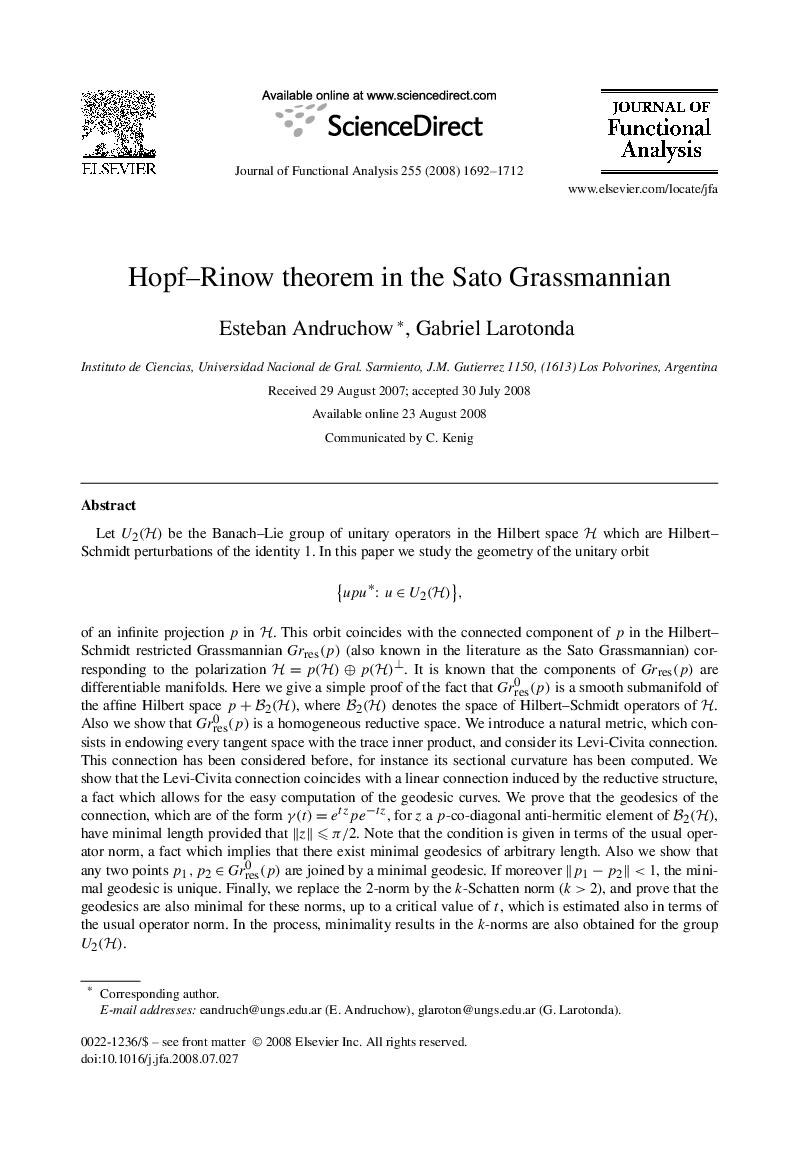| Article ID | Journal | Published Year | Pages | File Type |
|---|---|---|---|---|
| 4592712 | Journal of Functional Analysis | 2008 | 21 Pages |
Let U2(H)U2(H) be the Banach–Lie group of unitary operators in the Hilbert space HH which are Hilbert–Schmidt perturbations of the identity 1. In this paper we study the geometry of the unitary orbit{upu∗:u∈U2(H)}, of an infinite projection p in HH. This orbit coincides with the connected component of p in the Hilbert–Schmidt restricted Grassmannian Grres(p)Grres(p) (also known in the literature as the Sato Grassmannian) corresponding to the polarization H=p(H)⊕p(H)⊥H=p(H)⊕p(H)⊥. It is known that the components of Grres(p)Grres(p) are differentiable manifolds. Here we give a simple proof of the fact that Grres0(p) is a smooth submanifold of the affine Hilbert space p+B2(H)p+B2(H), where B2(H)B2(H) denotes the space of Hilbert–Schmidt operators of HH. Also we show that Grres0(p) is a homogeneous reductive space. We introduce a natural metric, which consists in endowing every tangent space with the trace inner product, and consider its Levi-Civita connection. This connection has been considered before, for instance its sectional curvature has been computed. We show that the Levi-Civita connection coincides with a linear connection induced by the reductive structure, a fact which allows for the easy computation of the geodesic curves. We prove that the geodesics of the connection, which are of the form γ(t)=etzpe−tzγ(t)=etzpe−tz, for z a p -co-diagonal anti-hermitic element of B2(H)B2(H), have minimal length provided that ‖z‖⩽π/2‖z‖⩽π/2. Note that the condition is given in terms of the usual operator norm, a fact which implies that there exist minimal geodesics of arbitrary length. Also we show that any two points p1,p2∈Grres0(p) are joined by a minimal geodesic. If moreover ‖p1−p2‖<1‖p1−p2‖<1, the minimal geodesic is unique. Finally, we replace the 2-norm by the k -Schatten norm (k>2k>2), and prove that the geodesics are also minimal for these norms, up to a critical value of t, which is estimated also in terms of the usual operator norm. In the process, minimality results in the k -norms are also obtained for the group U2(H)U2(H).
